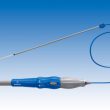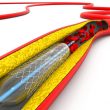We are interested in your opinion. Please, leave your comments, thoughts, questions, etc., below. They will be most welcome.
After 8-year Followup, Good News for the Self Expandable Valve
As the transcatheter aortic valve replacement (TAVR) gains ground in lower risk populations and with better survival rate, concern over its durability has grown. This study brings us data and good news on the first-generation self-expandable valve after quite a long follow up. It included 990 inoperable or high-risk patients treated with CoreValve in 8...
Subintimal Re-Entry in CTO Improves Outcomes
Courtesy of Dr. Carlos Fava. Chronic total occlusions (CTO) are still one of the greatest challenges in our field, thus forcing the development of different complex strategies to resolve them. Additionally, the use of imaging techniques during these procedures has improved long-term results. The CONSISTENT CTO (Conventional Antegrade Versus Sub-Intimal Synergy Stenting in Chronic Total Occlusions)...
European Association of Percutaneous Cardiovascular Interventions Position Statement During the Pandemic
This document emerges from the assembly of the European Association of Percutaneous Cardiovascular Interventions (EAPCI) and the Acute Cardiovascular Care Association (ACVC). Both associations gathered their most prominent experts, including people who worked in the European areas most affected by COVID-19. Their aim was to modify diagnostic and therapeutic algorithms to adapt the evidence collected...
The FDA Approves Ticagrelor for Primary Prevention in High Risk Patients
The FDA has approved the indication of ticagrelor as primary prevention in high risk CAD patients with no history of MI or stroke. The lab producing ticagrelor has informed the FDA has based this decision on the THEMIS study, which included nearly 20,000 patients with stable CAD and type 2 diabetes. This decision has come...
Stenting of Lipid-Rich vs Fibrous and calcified Plaques: Different Prognosis?
Coronary PCI with contemporary drug eluting stents (DES) in lipidic-rich plaques were not associated with increased periprocedural events at long term compared against plaques with no significant lipidic composition. This study recently published in J Am Coll Cardiol looked into the association between lipidic rich plaques detected by near-infrared spectroscopy (NIRS) and clinical events in...
Multiple vs. Culprit vessel MI in Cardiogenic Shock: Anything New?
The Shock Trial, the one that set revascularization as the standard strategy to treat all STEMI and cardiogenic shock lesions, had not been discussed for nearly 20 years. The CULPRIT-SHOCK was presented at TCT 2017 (and also in NEJM), and again this one study changed the standard completely, since we went back to treating only...
Compare-Acute Sub-Study: Natural History of Non-Culprit Lesions in MI
The aim of this study was to determine the prognostic value of fractional flow reserve (FFR) of non-culprit lesions in STEMI patients. We analyzed data of all Compare-Acute patients (Comparison Between FFR Guided Revascularization Versus Conventional Strategy in Acute STEMI Patients With MVD) after PCI, from lesions assessed with FFR and treated medically. The treating...
Priorities in the Cath Lab to Escape COVID-19 Tsunami
The pandemic tsunami of COVID-19 has hit all cath lab services, especially those performing primary PCI. Passively waiting for the first patient suspected of infection only to improvise in the early hours means heading for disaster. Several scientific societies have published recommendations, but not based on clear data. It seems pertinent to bear in mind...
SOLACI-CACI 2021 Preliminary Agenda
Check out the main topics of the upcoming SOLACI-CACI 2021 Congress. Save the Date! Special Session About the COVID-19 Pandemic Managing Cardiovascular disease and Cath Lab during the COVID-19 Pandemic Live Case Transmissions Coronary and Structural cases performed by distinguished international and national operators. Coronary Track Myocardial Infarction, Left Main session, Complex...








